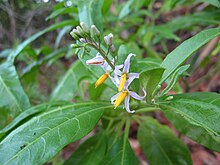| Bahama nightshade | |
|---|---|

| |
| Scientific classification | |
| Kingdom: | Plantae |
| Clade: | Tracheophytes |
| Clade: | Angiosperms |
| Clade: | Eudicots |
| Clade: | Asterids |
| Order: | Solanales |
| Family: | Solanaceae |
| Genus: | Solanum |
| Species: | S. bahamense
|
| Binomial name | |
| Solanum bahamense | |
| Synonyms | |
|
Synonymy
| |
Solanum bahamense, commonly known as the Bahama nightshade,[1] is a plant in the nightshade family. It is native across the West Indies, from the Florida Keys east to Dominica (excluding Hispaniola).[2] It is a common species in coastal habitats, often on calcareous soils.[2]
Taxonomy
[edit]Originally described by Carl Linnaeus, it has a convoluted taxonomic history. S. bahamense is known by many junior synonyms and involved in several cases of homonymy.[3]
Some additional varieties of S. bahamense have been described, but they are not considered taxonomically distinct today:[3]
- Solanum bahamense var. inerme Dunal
- Solanum bahamense var. lanceolatum Griseb. (Not to be confused with S. lanceolatum.)
- Solanum bahamense var. luxurians D'Arcy
- Solanum bahamense var. rugelii D'Arcy
- Solanum bahamense var. subarmatum (Willd.) O.E.Schulz
References
[edit]- ^ USDA, NRCS (n.d.). "Solanum bahamense". The PLANTS Database (plants.usda.gov). Greensboro, North Carolina: National Plant Data Team. Retrieved 17 November 2015.
- ^ a b Strickland-Constable, Rose; Schneider, Harold; Ansell, Stephen; Russell, Stephen; Knapp, Sandra (2010). "Species identify in the Solanum bahamense species group (Solanaceae, Solanum subgenus Leptostemonum)". Taxon. 59 (1): 209–226. doi:10.1002/tax.591020.
- ^ a b Solanaceae Source (2008). "Solanum bahamense". Retrieved September 26, 2008.
Well, that’s interesting to know that Psilotum nudum are known as whisk ferns. Psilotum nudum is the commoner species of the two. While the P. flaccidum is a rare species and is found in the tropical islands. Both the species are usually epiphytic in habit and grow upon tree ferns. These species may also be terrestrial and grow in humus or in the crevices of the rocks.
View the detailed Guide of Psilotum nudum: Detailed Study Of Psilotum Nudum (Whisk Fern), Classification, Anatomy, Reproduction